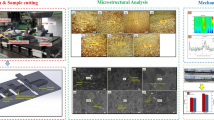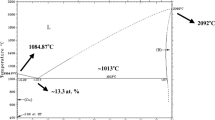Abstract
Nanocomposite lubricant additive consisting of Magnesium silicate hydroxide and amorphous carbon (MSH@C) was prepared. Amorphous carbon in the nanocomposite of MSH@C was obtained by hydrothermal decomposition of polytetrafluoroethylene (PTFE) under subcritical water condition. The MSH@C was characterized by Scanning electron microscope, X-ray diffractometer, Fourier transform infrared spectrometer, Raman spectrometer, and X-ray photoelectron spectrometer. The analysis results show that addition of PTFE in the process of synthesizing MSH can inhibit the tubular crystallization of MSH@C powder. Tribological experiments show that the doping of amorphous carbon materials can significantly enhance the friction reduction and wear resistance of nanocomposite powders as lubricant additive, and is superior to MSH and fully formulated commercial lubricant 5W30. The tribofilm on the worn balls including amorphous carbon originated from MSH@C nanoparticles accounts for the significant tribological properties.











Similar content being viewed by others
References
Titirici, M.M., White, R.J., Brun, N., Budarin, V.L., Su, D.S., Del Monte, F., Clark, J.H., MacLachlan, M.J.: Sustainable carbon materials. Chem. Soc. Rev. 44, 250–290 (2015)
Wang, R.X., Zhang, Y.H., Liao, Y.: Performance of rolling piston type rotary compressor using fullerenes (C70) and NiFe2O4 nanocomposites as lubricants additives. Front. Energy (2017). https://doi.org/10.1007/s11708-017-0453-y
Jiang, G.C., Yang, Y.Y.: Preparation and tribology properties of water-soluble fullerene derivative nanoball. Arab J. Chem. 10, S870–S876 (2017)
Yang, Z., Li, W.H., Chen, C.S., Chen, X.H., Xu, L.S.: Modification of multi-walled carbon nanotubes with fatty acid and their tribological properties as lubricant additive. Carbon 43, 1660–1666 (2005)
Lin, J.S., Wang, L.W., Chen, G.H.: Modification of graphene platelets and their tribological properties as a lubricant additive. Tribol. Lett. 41, 209–215 (2011)
Lee, C.G., Hwang, Y.J., Choi, Y.M., Lee, J.K., Choi, C., Oh, J.M.: A study on the tribological characteristics of graphite nano lubricants. Int. J. Precis. Eng. Manuf. 10, 85–90 (2009)
Yao, Y.L., Wang, X.M., Guo, J.J., Yang, X.W., Xu, B.S.: Tribological property of onion-like fullerenes as lubricant additive. Mater. Lett. 62, 2524–2527 (2008)
Vengudusamy, B., Mufti, R.A., Lamb, G.D., Green, J.H., Spikes, H.A.: Friction properties of DLC/DLC contacts in base oil. Tribol. Int. 44, 922–932 (2011)
Abdullah Tasdemir, H., Wakayama, M., Tokoroyama, T., Kousaka, H., Umehara, N., Mabuchi, Y., Higuchi, T.: Wear behaviour of tetrahedral amorphous diamond-like carbon (ta-C DLC) in additive containing lubricants. Wear 307, 1–9 (2013)
Vetter, J.: 60 years of DLC coatings: historical highlights and technical review of cathodic arc processes to synthesize various DLC types, and their evolution for industrial applications. Surf. Coat. Technol. 257, 213–240 (2014)
Sevilla, M., Fuertes, A.B.: The production of carbon materials by hydrothermal carbonization of cellulose. Carbon 47, 2281–2289 (2009)
Zhao, H.Y., Lu, X.A., Wang, Y., Sun, B., Wu, X.H., Lu, H.F.: Effects of additives on sucrose-derived activated carbon microspheres synthesized by hydrothermal carbonization. J. Mater. Sci. 52, 10787–10799 (2017)
Machado, N.T., de Castro, D.A.R., Santos, M.C., Araújo, M.E., Lüder, U., Herklotz, L., Werner, M., Mumme, J., Hoffmann, T.: Process analysis of hydrothermal carbonization of corn Stover with subcritical H2O. J. Supercrit. Fluids 136, 110–122 (2018)
Beckford, S., Cai, J., Chen, J., Zou, M.: Use of Au nanoparticle-filled PTFE films to produce low-friction and low-wear surface coatings. Tribol. Lett. 56, 223–230 (2014)
Salah, N., Alshahrie, A., Abdel-wahab, M.S., Alharbi, N.D., Khan, Z.H.: Carbon nanotubes of oil fly ash integrated with ultrathin CuO nanosheets as effective lubricant additives. Diam. Relat. Mater. 78, 97–104 (2017)
Song, W., Yan, J.C., Ji, H.B.: Tribological study of the SOCNTs@MoS2 composite as a lubricant additive: synergistic effect. Ind. Eng. Chem. Res. 57, 6878–6887 (2018)
Anand, G., Saxena, P.: A review on graphite and hybrid nano-materials as lubricant additives. IOP Conf. Ser. 149, 012201 (2016)
Chang, Q.Y., Rudenko, P., Miller, D.J., Wen, J.G., Berman, D., Zhang, Y.P., Arey, B., Zhu, Z.H., Erdemir, A.: Operando formation of an ultra-low friction boundary film from synthetic magnesium silicon hydroxide additive. Tribol. Int. 110, 35–40 (2017)
Van Der Walt, I.J., Bruinsma, O.S.L.: Depolymerization of clean unfilled PTFE waste in a continuous process. J. Appl. Polym. Sci. 102, 2752–2759 (2006)
Sugama, T., Sabatini, R., Petrakis, L.: Decomposition of chrysotile asbestos by fluorosulfonic acid. Ind. Eng. Chem. Res. 37, 79–88 (1998)
Yamaguchi, A., Kido, H., Ukita, Y., Kishihara, M., Utsumi, Y.: Anisotropic pyrochemical microetching of poly(tetrafluoroethylene) initiated by synchrotron radiation-induced scission of molecule bonds. Appl. Phys. Lett. 108(5), 1–5 (2016)
Anbalagan, G., Sivakumar, G., Prabakaran, A.R., Gunasekaran, S.: Spectroscopic characterization of natural chrysotile. Vib. Spectrosc. 52(2), 122–127 (2010)
Ristić, M., Czakó-Nagy, I., Musić, S., Vértes, A.: Spectroscopic characterization of chrysotile asbestos from different regions. J. Mol. Struct. 993, 120–126 (2011)
Liu, S., Gangopadhyay, S., Sreenivas, G., Ang, S., Naseem, H.: Infrared studies of hydrogenated amorphous carbon (a-C:H) and its alloys (a-C:H, N, F). Phys. Rev. B 55, 13020–13024 (1997)
Tang, C.J., Neves, A.J., Carmo, M.C.: Infrared absorption study of hydrogen incorporation in thick nanocrystalline diamond films. Appl. Phys. Lett. 86, 1–3 (2005)
Llamas-Jansa, I., Jäger, C., Mutschke, H., Henning, T.: Far-ultraviolet to near-infrared optical properties of carbon nanoparticles produced by pulsed-laser pyrolysis of hydrocarbons and their relation with structural variations. Carbon 45, 1542–1557 (2007)
Lua, A.C., Yang, T.: Effect of activation temperature on the textural and chemical properties of potassium hydroxide activated carbon prepared from pistachio-nut shell. J. Colloid Interface Sci. 274(2), 594–601 (2004)
Ferrari, A.C., Robertson, J.: Resonant Raman spectroscopy of disordered, amorphous, and diamondlike carbon. Phys. Rev. B 64(7), 075414 (2001)
Jawhari, T., Roid, A., Casado, J.: Raman spectroscopic characterization of some commercially available carbon black materials. Carbon 33, 557–563 (1990)
Sadezky, A., Muckenhuber, H., Grothe, H., Niessner, R., Pöschl, U.: Raman microspectroscopy of soot and related carbonaceous materials: spectral analysis and structural information. Carbon 43, 1731–1742 (2005)
Ferrari, A.C., Robertson, J.: Interpretation of Raman spectra of disordrred and amorphous carbon. Phys. Rev. B 61, 096–107 (1999)
Leung, T.Y., Man, W.F., Lim, P.K., Chan, W.C., Gaspari, F., Zukotynski, S.: Determination of the sp3/sp2 ratio of a-C: H by XPS and XAES. J. Non Cryst. Solids 254, 156–160 (1999)
Schulze, R.K., Hill, M.A., Field, R.D., Papin, P.A., Hanrahan, R.J., Byler, D.D.: Characterization of carbonated serpentine using XPS and TEM. Energy Convers. Manage. 45, 3169–3179 (2004)
Berman, D., Erdemir, A., Sumant, A.V.: Reduced wear and friction enabled by graphene layers on sliding steel surfaces in dry nitrogen. Carbon 59, 167–175 (2013)
Baratto, C., Lottici, P.P., Bersani, D., Antonioli, G., Montenero, A.: Sol-Gel preparation of α-Fe2 O3 thin films: structural characterization by XAFS and Raman. J. Sol-Gel. Sci. Technol. 4, 667–671 (1998)
Hanesch, M.: Raman spectroscopy of iron oxides and (oxy)hydroxides at low laser power and possible applications in environmental magnetic studies. Geophys. J. Int. 177, 941–948 (2009)
Thanos, I.C.G.: Electrochemical reduction of thermally prepared oxides of iron and iron-chromium alloys studied by in situ Raman spectroscopy. Electrochim. Acta 31, 1585–1595 (1986)
Maslar, J.E., Hurst, W.S., Bowers, J.J., Hendricks, J.H.: In situ Raman spectroscopic investigation of stainless steel hydrothermal corrosion. Corrosion 58, 739–747 (2002)
Wang, B., Chang, Q.Y., Gao, K., Fang, H.R., Qing, T., Zhou, N.N.: The synthesis of magnesium silicate hydroxide with different morphologies and the comparison of their tribological properties. Tribol. Int. 119, 672–679 (2018)
Acknowledgements
This work was funded by Equipment Development Department of the Central Military Commission Foundation, China (Grant No. JZX7Y20190262063601, JZX7Y20190263069101) and Beijing Key Laboratory of Long-life Technology of Precise Rotation and Transmission Mechanisms Foundation, China (Grant No. BZ0388201801).
Author information
Authors and Affiliations
Corresponding author
Ethics declarations
Conflict of interest
The authors declare that they have no conflict of interest.
Additional information
Publisher's Note
Springer Nature remains neutral with regard to jurisdictional claims in published maps and institutional affiliations.
Rights and permissions
About this article
Cite this article
Chang, Q., Zhang, H. & Gao, R. Amorphous Carbon Doping Nano-Magnesium Silicate Hydroxide with Significant Tribological Property. Tribol Lett 67, 76 (2019). https://doi.org/10.1007/s11249-019-1194-3
Received:
Accepted:
Published:
DOI: https://doi.org/10.1007/s11249-019-1194-3




